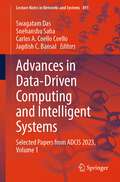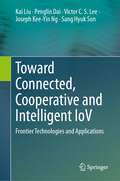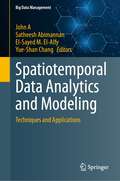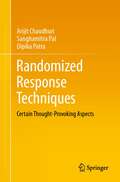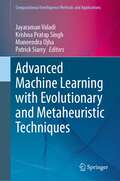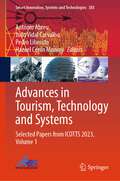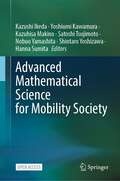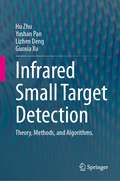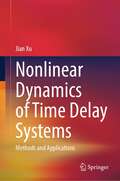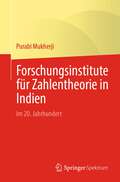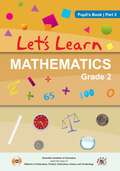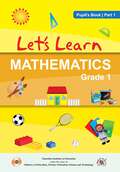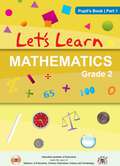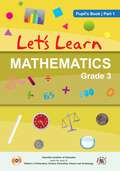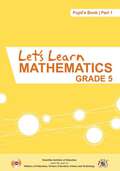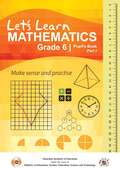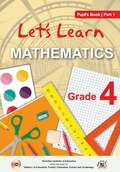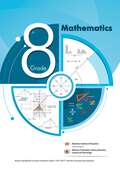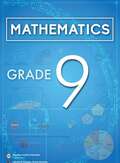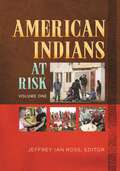- Table View
- List View
The Bergman Kernel and Related Topics: Hayama Symposium on SCV XXIII, Kanagawa, Japan, July 2022 (Springer Proceedings in Mathematics & Statistics #447)
by Kengo Hirachi Takeo Ohsawa Shigeharu Takayama Joe KamimotoThis volume consists of 15 papers contributing to the Hayama Symposium on Complex Analysis in Several Variables XXIII, which was dedicated to the 100th anniversary of the creation of the Bergman kernel. The symposium took place in Hayama and Tokyo in July 2022. Each article is closely related to the Bergman kernel, covering topics in complex analysis, differential geometry, representation theory, PDE, operator theory, and complex algebraic geometry. Specifically, some papers address the L2 extension operators from a newly opened viewpoint after solving Suita's conjecture for the logarithmic capacity. They are also continuations of quantitative solutions to the openness conjecture for the multiplier ideal sheaves. The study involves estimates for the solutions of the d-bar equations, focusing on the existence of compact Levi-flat hypersurfaces in complex manifolds. The collection also reports progress on various topics, including the existence of extremal Kähler metrics on compact manifolds, Lp variants of the Bergman kernel, Wehrl-type inequalities, homogeneous Kähler metrics on bounded homogeneous domains, asymptotics of the Bergman kernels, and harmonic Szegő kernels and operators on the Bergman spaces and Segal-Bargmann spaces. Some of the papers are written in an easily accessible way for beginners. Overall, this collection updates how a basic notion provides strong insights into the internal relationships between independently found phenomena.
Advances in Data-Driven Computing and Intelligent Systems: Selected Papers From Adcis 2022, Volume 1 (Lecture Notes In Networks And Systems Ser. #698)
by Swagatam Das Snehanshu Saha Carlos A. Coello Coello Jagdish C. BansalFinancial Mathematics, Derivatives and Structured Products
by Raymond H. Chan Spike T. Lee Xun Li Yves ZY. GuoThis book introduces readers to the financial markets, derivatives, structured products and how the products are modelled and implemented by practitioners. In addition, it equips readers with the necessary knowledge of financial markets needed in order to work as product structurers, traders, sales or risk managers.This second edition substantially extends, updates and clarifies the previous edition. New materials and enhanced contents include, but not limited to, the role of central counterparties for derivatives transactions, the reference rates to replace LIBOR, risk-neutral modelling for futures and forward, discussions and analysis on risk-neutral framework and numéraires, discrete dividend modelling, variance reduction techniques for Monte Carlo method, finite difference method analysis, tree method, FX modelling, multi-name credit derivatives modelling, local volatility model, forward variance model and local-stochastic volatility model to reflect market practice.As the book seeks to unify the derivatives modelling and the financial engineering practice in the market, it will be of interest to financial practitioners and academic researchers alike. The book can also be used as a textbook for the following courses:• Financial Mathematics (undergraduate level)• Stochastic Modelling in Finance (postgraduate level)• Financial Markets and Derivatives (undergraduate level)• Structured Products and Solutions (undergraduate/postgraduate level)
Toward Connected, Cooperative and Intelligent IoV: Frontier Technologies and Applications
by Kai Liu Penglin Dai Victor C.S. Lee Joseph Kee-Yin Ng Sang Hyuk SonThis book offers a comprehensive introduction to technological advances in Internet of Vehicles (IoV), including vehicular communications, vehicular system architectures, data dissemination algorithms, resource allocation schemes, and AI-enabled applications. It focuses on the state-of-the-art IoV with regard to three major directions, namely networking, cooperation, and intelligence, including advanced wireless communication technologies, algorithm theory, optimization mechanisms, and AI technologies. In addition, the book includes a number of case studies with system prototype implementation and hands-on experiments in IoV, making it suitable both as a technical reference work for professionals and as a textbook for graduate students.
Spatiotemporal Data Analytics and Modeling: Techniques and Applications (Big Data Management)
by John A Satheesh Abimannan El-Sayed M. El-Alfy Yue-Shan ChangWith the growing advances in technology and transformation to digital services, the world is becoming more connected and more complex. Huge heterogeneous data are generated at rapid speed from various types of sensors. Augmented with artificial intelligence and machine learning and internet of things, latent relations, and new insights can be captured helping in optimizing plans and resource utilization, improving infrastructure, and enhancing quality of services. A “spatial data management system” is a way to take care of data that has something to do with space. This could include data such as maps, satellite images, and GPS data. A temporal data management system is a system designed to manage data that has a temporal component. This could include data such as weather data, financial data, and social media data. Some advanced techniques used in spatial and temporal data management systems include geospatial indexing for efficient querying and retrieval of location-based data, time-series analysis for understanding and predicting temporal patterns in datasets like weather or financial trends, machine learning algorithms for uncovering hidden patterns and correlations in large and complex datasets, and integration with Internet of Things (IoT) technologies for real-time data collection and analysis. These techniques, augmented with artificial intelligence, enable the extraction of latent relations and insights, thereby optimizing plans, improving infrastructure, and enhancing the quality of services. This book provides essential technical knowledge, best practices, and case studies on the state-of-the-art techniques of artificial intelligence and machine learning for spatiotemporal data analysis and modeling. The book is composed of several chapters written by experts in their fields and focusing on several applications including recommendation systems, big data analytics, supply chains and e-commerce, energy consumption and demand forecasting,and traffic and environmental monitoring. It can be used as academic reference at graduate level or by professionals in science and engineering related fields such as data science and engineering, big data analytics and mining, artificial intelligence, machine learning and deep learning, cloud computing, and internet of things.
Randomized Response Techniques: Certain Thought-Provoking Aspects
by Arijit Chaudhuri Sanghamitra Pal Dipika PatraThis book presents an up-to-date perspective on randomized response techniques (RRT). It discusses the most appropriate and efficient procedures of RRT for analysing data from queries dealing with sensitive and confidential issues, including the treatment of infinite and finite population setups. The book aims to spark a renewed interest among sampling experts who may have overlooked RRT. By addressing the missing topics and incorporating a wide range of contributors' works, it seeks to foster an appreciative academic environment and inspire a reformed and amended view of RRT. As the book unfolds, readers will gain valuable insights into the evolving landscape of RRT and its applications, positioning them at the forefront of this engaging field of study.On RRT, the literature has grown immensely since its inception in 1965 by S.L. Warner. Despite several books published on the subject, there are still two crucial topics missing from the existing RRT literature. This book aimsto address these gaps and provide valuable insights to curious readers in the field. The book is mandatory reading for statisticians and biostatisticians, market researchers, operations researchers, pollsters, sociologists, political scientists, economists and advanced undergraduate and graduate students in these areas.
Advanced Machine Learning with Evolutionary and Metaheuristic Techniques (Computational Intelligence Methods and Applications)
by Jayaraman Valadi Krishna Pratap Singh Muneendra Ojha Patrick SiarryThis book delves into practical implementation of evolutionary and metaheuristic algorithms to advance the capacity of machine learning. The readers can gain insight into the capabilities of data-driven evolutionary optimization in materials mechanics, and optimize your learning algorithms for maximum efficiency. Or unlock the strategies behind hyperparameter optimization to enhance your transfer learning algorithms, yielding remarkable outcomes. Or embark on an illuminating journey through evolutionary techniques designed for constructing deep-learning frameworks. The book also introduces an intelligent RPL attack detection system tailored for IoT networks. Explore a promising avenue of optimization by fusing Particle Swarm Optimization with Reinforcement Learning. It uncovers the indispensable role of metaheuristics in supervised machine learning algorithms. Ultimately, this book bridges the realms of evolutionary dynamic optimization andmachine learning, paving the way for pioneering innovations in the field.
Advances in Tourism, Technology and Systems: Selected Papers from ICOTTS 2023, Volume 1 (Smart Innovation, Systems and Technologies #383)
by António Abreu João Vidal Carvalho Pedro Liberato Hazael Cerón MonroyThis book features a collection of high-quality research papers presented at the International Conference on Tourism, Technology and Systems (ICOTTS 2023), held at Anáhuac University, Bacalar, Mexico, from 2 to 4 November 2023. The book is divided into two volumes, and it covers the areas of technology in tourism and the tourist experience, generations and technology in tourism, digital marketing applied to tourism and travel, mobile technologies applied to sustainable tourism, information technologies in tourism, digital transformation of tourism business, e-tourism and tourism 2.0, big data and management for travel and tourism, geotagging and tourist mobility, smart destinations, robotics in tourism, and information systems and technologies.
Advanced Mathematical Science for Mobility Society
by Kazushi Ikeda Yoshiumi Kawamura Kazuhisa Makino Satoshi Tsujimoto Nobuo Yamashita Shintaro Yoshizawa Hanna SumitaThis open access book presents the mathematical methods for huge data and network analysis.The automotive industry has made steady progress in technological innovations under the names of Connected Autonomous-Shared-Electric (CASE) and Mobility as a Service (MaaS). Needless to say, mathematics and informatics are important to support such innovations. As the concept of cars and movement itself is diversifying, they are indispensable for grasping the essence of the future mobility society and building the foundation for the next generation. Based on this idea, Research unit named "Advanced Mathematical Science for Mobility Society" was established at Kyoto University as a base for envisioning a future mobility society in collaboration with researchers led by Toyota Motor Corporation and Kyoto University.This book contains three main contents.1. Mathematical models of flow2. Mathematical methodsfor huge data and network analysis3. Algorithm for mobility societyThe first one discusses mathematical models of pedestrian and traffic flow, as they are important for preventing accidents and achieving efficient transportation. The authors mainly focus on global dynamics caused by the interaction of particles. The authors discuss many-body particle systems in terms of geometry and box-ball systems. The second one consists of four chapters and deals with mathematical technologies for handling huge data related to mobility from the viewpoints of machine learning, numerical analysis, and statistical physics, which also includes blockchain techniques. Finally, the authors discuss algorithmic issues on mobility society. By making use of car-sharing service as an example of mobility systems, the authors consider how to construct and analyze algorithms for mobility system from viewpoints of control, optimization, and AI.
Basic Immunology and Its Clinical Application (Advances in Experimental Medicine and Biology #1444)
by Mitsuru MatsumotoThis book overviews ongoing and upcoming clinical applications of basic immunology. Recent advances in our knowledge of immunology coupled with new technologies have aided in the development of efficient cancer immunotherapy, as well as the control of emerging microorganisms such as SARS-CoV-2. However, knowledge of basic immunology has not been fully utilized even after the discoveries of immune checkpoint inhibition for cancer immunotherapy and the development of mRNA vaccination against SARS-CoV-2. There is still room for improving the clinical application of basic immunology. The book summarizes the achievements in clinical applications of basic immunology and highlights what can be further extended to make immunology a more practical human science. Basic immunology and its clinical applications are two wheels of the same cart in the immunology field, which aids in the development of more efficient cancer immunotherapy and rapid control of infectious diseases against microorganisms, including new viruses and classical toxoplasmosis. The exploration of ongoing and upcoming applications of basic immunology in this book makes it a useful resource for immunologists, physicians, molecular and genome biologists, bioinformaticians, and students in these fields.
Infrared Small Target Detection: Theory, Methods, and Algorithms.
by Hu Zhu Yushan Pan Lizhen Deng Guoxia XuUncover the secrets of cutting-edge research in “Infrared Small Target Detection,” a crucial resource that delves into the dynamic world of infrared imaging and detection algorithms. This comprehensive book is an indispensable gem for the research community, offering a profound introduction to the theory, methods, and algorithms underlying infrared small object detection. As an invaluable guide, this book explores diverse models and categories of infrared small object detection algorithms, providing meticulous descriptions and comparisons of their strengths and limitations. Perfectly tailored for researchers, practitioners, and students with a passion for infrared imaging and detection, this book equips readers with the necessary knowledge to embark on groundbreaking investigations in this field.Readers can particularly be drawn to the book's methods, results, and topics, encompassing diverse categories of infrared small object detection algorithms and their corresponding advantages and disadvantages. The book also imparts foundational knowledge in mathematical morphology, tensor decomposition, and deep learning, enabling readers to grasp the underlying principles of these advanced algorithms. Experience the key benefits of “Infrared Small Target Detection” as readers gain a profound understanding of theory, methods, and algorithms tailored to infrared small object detection. The comprehensive descriptions and comparisons of various algorithm categories empower readers to select the perfect algorithms for their specific applications. Unlock the potential of this groundbreaking resource with a basic understanding of mathematics, statistics, and image processing. Some familiarity with infrared imaging and detection proves advantageous in fully immersing oneself in the wealth of knowledge presented within these pages.
Nonlinear Dynamics of Time Delay Systems: Methods and Applications
by Jian XuThis book presents research advancements in the dynamics of systems with time delay conducted by the group led by Professor Jian Xu. Addressing the challenges arising from the joint impact of time delay and nonlinearity, novel theoretical approaches are developed to formulate the nonlinear response of the system. This facilitates the classification of complex nonlinear dynamics, especially the non-resonant and resonant double Hopf bifurcation. In contrast to systems without time delay, time delay systems require specific considerations when identifying system parameters, particularly the time delay. Consequently, inverse problems of systems with time delay are also explored in this book. Moreover, detailed investigations on vibration suppression methods and experimental prototypes based on time delay, such as time delay isolators with quasi-zero stiffness, are conducted. Simultaneously, this book is enriched with a large number of case studies ranging from manufacturing, network science, biology, and public transportation, illuminating the mechanisms of delay-induced nonlinear dynamics in practical applications. This book is suitable for graduate students and researchers who are eager to understand the delay-induced nonlinear dynamics, or technical personnel in whose projects small variations of time delay may cause significant changes in system responses.
Forschungsinstitute für Zahlentheorie in Indien: Im 20. Jahrhundert
by Purabi MukherjiDieses Buch versucht, die schrittweise Entwicklung der wichtigsten Forschungsinstitute zur Zahlentheorie in Südindien, Punjab, Mumbai, Bengalen und Bihar zu beschreiben, einschließlich der Gründung des Tata Institute of Fundamental Research (TIFR) in Mumbai, einem bahnbrechenden Ereignis in der Geschichte der Zahlentheorie-Forschung in Indien. Die Forschung zur Zahlentheorie in Indien begann in der modernen Zeit mit dem Auftreten des ikonischen Genies Srinivasa Ramanujan, das Mathematiker auf der ganzen Welt inspirierte. Das Buch diskutiert die nationale und internationale Wirkung der Forschung indischer Zahlentheoretiker und enthält eine sorgfältig zusammengestellte, umfassende Bibliographie bedeutender indischer Zahlentheoretiker des 20. Jahrhunderts. Es ist wichtig für die historische Dokumentation und eine wertvolle Ressource für Forscher auf diesem Gebiet. Das Buch diskutiert auch kurz die Bedeutung der Zahlentheorie in der modernen Mathematik, einschließlich Anwendungen der Ergebnisse indigener Zahlentheoretiker in praktischen Bereichen. Da das Buch aus der Perspektive der Wissenschaftsgeschichte geschrieben ist, wurden technische Fachbegriffe und mathematische Ausdrücke so weit wie möglich vermieden.Die Übersetzung wurde mit Hilfe von künstlicher Intelligenz durchgeführt. Eine anschließende menschliche Überarbeitung erfolgte vor allem in Bezug auf den Inhalt.
Let’s Learn Mathematics Part-2 - Pupil's Book class 2 - MIE
by Mauritius Institute of EducationThe Mathematics Grade 6 Pupil’s Book Part 2, designed for students in Mauritius, is a comprehensive textbook developed by the Mauritius Institute of Education and the Ministry of Education and Human Resources. The textbook comprises of units covering diverse mathematical topics like patterns, sequences, powers, time, area, percentages, averages, ratio, proportion, angles, charts, coordinates, line graphs, volume, speed, and problem-solving. Each unit begins with clear learning objectives and concludes with activities to assess students' understanding and skills. The content is reinforced with examples, diagrams, tables, and pictograms to illustrate concepts and methods. Additionally, appendices at the end provide valuable templates for creating 3-D cubes and cuboids, along with examples of shapes and their names. This well-structured textbook aims to enhance students' mathematical proficiency through engaging content and practical exercises.
Let’s Learn Mathematics Part-1 - Pupil’s Book class 1 - MIE
by Mauritius Institute of EducationThe Mathematics Pupil’s Book Part 1 for Grade 1 offers a comprehensive foundation for young learners in fundamental mathematical concepts aligned with the National Curriculum Framework. Structured around three engaging themes - Home, School, and Games - the textbook incorporates a variety of activities, such as drawing, tracing, writing, coloring, matching, sorting, and comparing objects and numbers. These activities are designed to be interactive and enjoyable, fostering a child-friendly learning environment. Clear learning objectives and outcomes are outlined for each theme and unit, accompanied by continuous assessment and profiling exercises to gauge student progress. The textbook also features an annex with a memory game to reinforce recognition of shapes, colors, and numbers. Overall, it provides a well-rounded and interactive approach to cultivating essential mathematical skills in Grade 1 students.
Let’s Learn Mathematics Part-1 - Pupil's Book class 2 - MIE
by Mauritius Institute of EducationThe Grade 2 Mathematics Workbook and Teacher’s Book align with the philosophical principles of the New Curriculum Framework (Primary) and extend the pedagogical approaches from Grade 1. Designed to facilitate a smooth transition, the materials aim to enhance pupils' understanding and enjoyment of key mathematical concepts. Concepts are introduced sequentially through engaging stories, connecting them to real-life contexts, with an emphasis on interdisciplinary links, life skills, and ICT integration. Child-friendly presentation and progressive activities aid comprehension, while continuous assessment and profiling support educators in monitoring pupil progress. The role of educators as facilitators is underscored, encouraging them to leverage the 'Note to Teacher' for effective conceptual understanding. The Mathematics Panel anticipates that these curriculum materials will instill enjoyment and foster a deeper interest in the study of Mathematics among pupils.
Let’s Learn Mathematics Part-1 - Pupil’s Book class 3 - MIE
by Mauritius Institute of EducationThe Grade 3 Mathematics Pupil’s Book Part 1 offers a comprehensive exploration of key mathematical concepts essential for third-grade students. It covers Geometry, introducing shapes, sides, vertices, patterns, tessellation, and activities integrating ICT tools like Ms Paint. Additionally, it delves into Graphs, teaching how to understand and create pictograms, count shapes, and interpret data using ICT tools. The book also focuses on Numbers, from 0 to 1000, emphasizing place value, number sequences, and exercises involving the abacus and number lines. Furthermore, it addresses Addition techniques, including adding numbers with and without carrying, solving word problems, and utilizing ICT for practice. Mass concepts, such as comparing weights and practical activities to grasp kilograms, are also covered. Emphasizing technology in learning, the book incorporates continuous assessment and profiling sections to monitor student progress effectively.
Let's Learn Mathematics Part-1 - Pupil's Book class 5 - MIE
by Mauritius Institute of EducationThe "MATHEMATICS Grade 5 Pupil’s Book Part 1" is a comprehensive textbook crafted by a panel of mathematics experts from the Mauritius Institute of Education and the Ministry of Education and Human Resources, Tertiary Education and Scientific Research. Designed for Grade 5 students in Mauritius, the book covers essential aspects of the mathematics curriculum, including numeration, notation, geometry, fractions, and powers. With a vibrant and visually appealing layout, the book features clear learning objectives, engaging activities, illustrative examples, and diverse exercises for practice. Aligned with the national curriculum framework, it incorporates continuous assessments to gauge understanding. The book employs a friendly tone to inspire students, providing encouragement, tips, and hints, and includes questions, puzzles, and games to foster curiosity. Intended for students, teachers, and parents, this resource aims to cultivate mathematical proficiency, skills, confidence, appreciation, and interest in young learners.
Let's Learn Mathematics Part-1 - Pupil's Book class 6 - MIE
by Mauritius Institute of EducationGrade 6 part 1 mathematics textbook follows the National Curriculum Framework, encompassing units on shapes, numeration, fractions, decimals, and problem-solving techniques. The curriculum introduces students to 2-D and 3-D shapes, emphasizing properties, classification, and drawing techniques. Numeration and place value cover reading and writing large numbers, using tools like arrays and abacus. The text explores division with remainders, methods for comparing quantities, and the concepts of fractions and decimals, detailing addition, subtraction, multiplication, and division operations. Problem-solving strategies like thinking blocks and drawing diagrams are introduced with examples spanning various real-world scenarios. The book includes continuous assessments and challenging problems across multiple mathematical domains, fostering problem-solving skills. Motivational quotes from mathematicians and scientists aim to inspire students, while thorough references provide additional resources. Answers are provided with explanations, utilizing LaTeX for mathematical expressions. This comprehensive textbook aims to engage and empower Grade 6 pupils in their mathematical learning journey.
Let's Learn Mathematics Part-1 - Pupil's Book class 4 - MIE
by Mauritius Institute of EducationThe Mathematics Grade 4 Pupil's Book Part 1 for Mauritius encompasses a comprehensive curriculum divided into eight units. It begins with foundational skills in numeration, addition, subtraction, multiplication, and division, progressing to more advanced concepts like patterns, even and odd numbers, and fractions. The foreword and preface introduce the book's objectives, layout, and contributors, while the table of contents aids navigation. Learning objectives emphasize key skills pupils should master, including numerical operations and problem-solving. Each unit features subtopics, examples, exercises, activities, an IT corner, and continuous assessment. From numeration and notation to fractions, the textbook systematically guides students through the mathematical landscape. A final revision sheet consolidates learning, offering a thorough review with diverse question types and answers, ensuring a holistic grasp of Grade 4 mathematics.
Mauritius Mathematics Grade 7 (Part-II) - MIE
by Mauritius Institute of EducationThe Mathematics Grade 7 textbook by Mauritius Institute of Education.
Mathematics class 7 - MIE
by Mauritius Institute of EducationThe Grade 7 Mathematics textbook, authored by Professor Vassen Naëck and a team from the Mauritius Institute of Education, serves as a vital resource in aligning with the National Curriculum Framework, guiding students through a seamless transition from Grade 6 to secondary education. Its comprehensive content spans Numbers, Algebra, Measures, Geometry, and Probability + Statistics, emphasizing problem-solving and real-world applications. Utilizing a pedagogical approach that prioritizes sense-making and reasoning, the textbook integrates digital tools like GeoGebra to deepen understanding. With various icons highlighting activities, exercises, and notes, the text promotes interactive and engaging learning experiences, fostering a deeper comprehension of mathematical concepts.
Mathematics class 8 - MIE
by Mauritius Institute of EducationThe Grade 8 Mathematics textbook by the Mauritius Institute of Education, published in 2021, presents a comprehensive curriculum aligned with the National Curriculum Framework. It covers diverse mathematical topics, including number sequences, indices, rate and proportion, coordinates, algebra, and geometry. Each chapter begins with clear learning objectives and provides ample exercises, examples, and summaries to aid comprehension. Emphasizing real-life applications, the textbook illustrates concepts such as Fibonacci sequences in nature and architectural scales, fostering contextual learning. The educational content is meticulously crafted to enhance learners' cognitive skills through practical activities and contextualized problem-solving. This textbook serves as an invaluable resource for Grade 8 students, facilitating their mathematical understanding and application in various real-world scenarios.
Mathematics class 9 - MIE
by Mauritius Institute of EducationPublished by the Mauritius Institute of Education in 2021, the Grade 9 mathematics textbook offers a comprehensive alignment with the National Curriculum Framework, prioritizing the enhancement of learners' cognitive abilities through contextualized materials. Covering a range of topics including indices, binomial expressions, quadratics, and algebraic manipulation, the textbook incorporates exercises and continuous assessments to reinforce learning. Rooted in Variation Theory, the pedagogical approach aims to facilitate students' discernment of key concepts within each topic, fostering procedural fluency. This collaborative effort between MIE academics and seasoned educators ensures the delivery of high-quality content that effectively meets educational objectives, providing students with a solid foundation in mathematics.
American Indians at Risk [2 volumes]: [2 volumes]
by Jeffrey Ian RossThis essential reference work enables a deeper understanding of contemporary challenges in the lives of American Indians and Alaskan Natives today, carefully reviewing their unique problems and proposing potential solutions.American Indians face problems in their lives on a daily basis that most other Americans never contend with, and their challenges—which in some cases are similar to those of other minority groups in the United States—are still qualitatively unique. American Indians at Risk gives readers a broad overview of what life in Indian country is like, addressing specific contemporary social issues such as alcoholism, unemployment, and suicide. The author goes beyond detailed descriptions of the problems of American Indians to also present solutions, some of which have been effective in addressing these challenges. Each chapter includes a "Further Investigations" section that presents helpful ideas for additional research.

